Reading the Chinese Garden
Posted on Fri., Dec. 28, 2018 by
The garden's curator contemplates its poetry
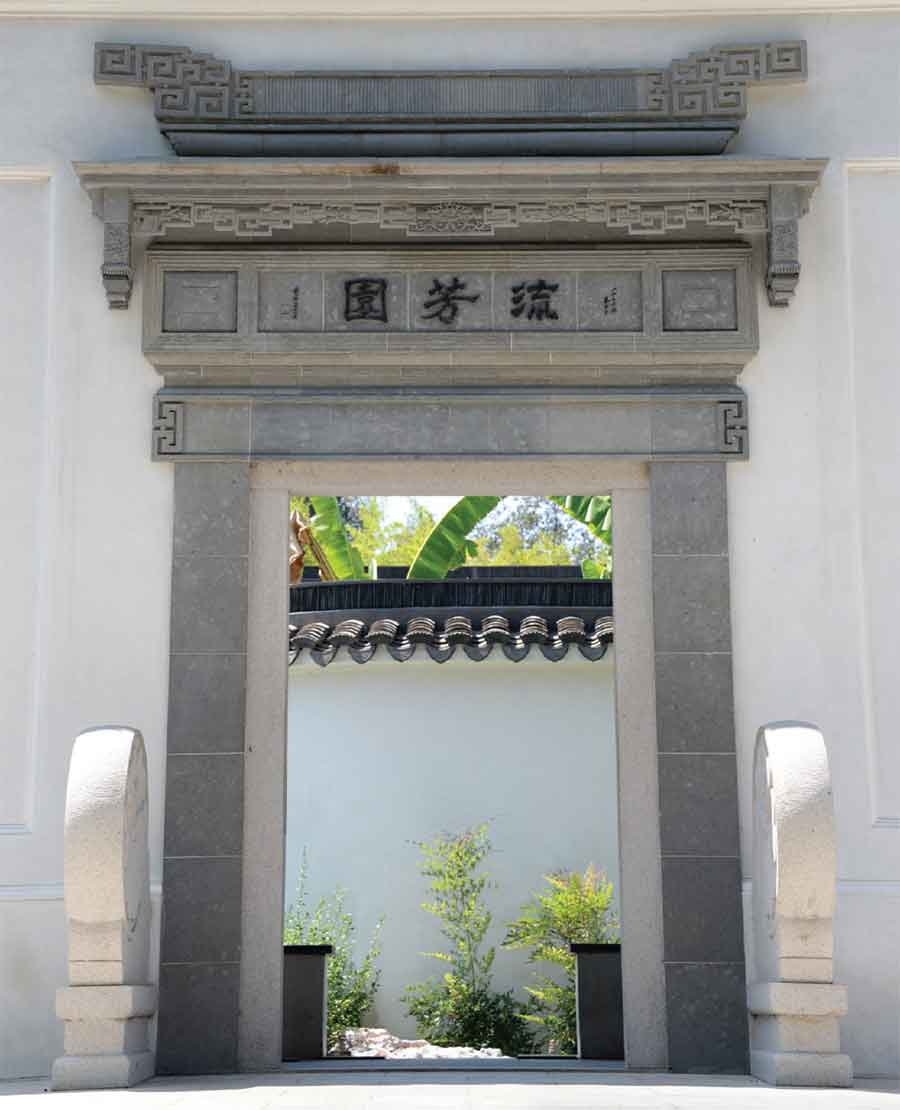
The main entrance to The Huntington’s Liu Fang Yuan 流芳園 (Garden of Flowing Fragrance). Photograph by Deborah Miller.
With the start of the final phase of the Chinese Garden’s construction, we asked the garden’s curator, Phillip E. Bloom, who joined The Huntington in September 2017, to reflect on two of the initial features installed in 2008—the garden’s entryway and the rustic thatch-roofed pavilion that sits along the stream below the garden walls. Whereas architecture, rocks, and the broader landscape shape one’s general experience of the Garden of Flowing Fragrance, Chinese calligraphy also enlivens many features: some inscriptions are the names of the buildings themselves; others comprise short poems that encourage deeper appreciation of the site. Beginning in 2006, the founding curator of the Chinese Garden, T. June Li, convened a group of advisers—including scholar and collector Wan-go H. C. Weng, UCLA professor Richard Strassberg, and UC Riverside professor Yang Ye—to propose names for the garden’s major structures and select poetic couplets to adorn them. The names provide poetic inspiration or invoke layered references to beloved works of Chinese literature. By including such literary features, Liu Fang Yuan draws inspiration from Ming-dynasty (1368–1644) gardens of Suzhou—a historical center of Chinese garden-making—built by scholars-officials (lettered bureaucrats who served in the imperial government) and merchants.
Chinese gardens are spaces of immediate sensory appeal: their fragrant flora entice the nose, their flowing waters soothe the ear, their textures attract the hand, their vistas allure the eye, and their tea even charms the tongue. But elite Chinese gardens—be they the grand imperial parks of the north, the colorful merchants’ quarters of the south, or the elegant scholarly retreats of Suzhou—are also sites that are meant to be read.
Especially since the 17th century, text has abounded in Chinese gardens: names are inscribed on buildings, bridges, and rocks; poetic couplets adorn doorways and columns. Collectively, the writings typically speak of the garden-owner’s personal interests, character, and values. For example, a high-minded government official might fill a garden with names inspired by the Confucian classics, the philosophical texts that undergirded imperial China’s system of governance; a literature lover, meanwhile, might draw from the works of a writer whose spirit he particularly admired.
One of the favorite themes invoked in the name placards and couplets of gardens constructed in premodern China (that is, before the end of imperial rule in 1911) was the ideal of reclusion—the notion that the garden is a place to which the garden-owner could retreat from the busyness of bureaucracy or the frustrations of business to pursue scholarly pleasures. Such leisure activities might include the composition of poetry, the rendering of calligraphy or painting, and the consumption of tea with like-minded companions. In choosing apt names for the features of a garden, and in engaging in such pursuits, the owner could communicate to his peers that he maintained the lofty heart of a hermit, a cherished figure in Chinese literature, despite being mired in the messiness of the court or the marketplace. In truth, reclusion was often more rhetorical than real: private gardens were spaces of extensive social interaction between owners and their peers; some gardens were even opened to the public for a fee.
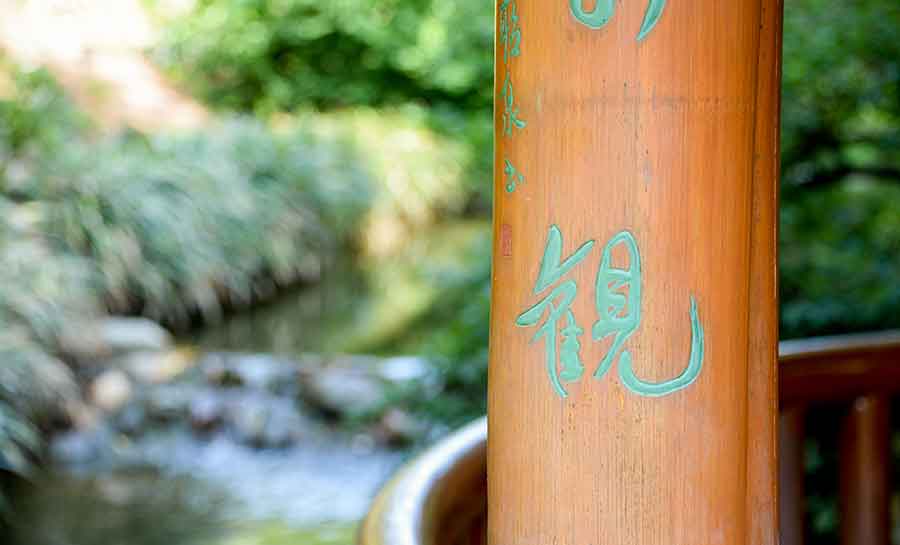
Detail of a poetic couplet that adorns the Pavilion for Washing Away Thoughts (Di Lü Ting 滌慮亭). Photograph by Deborah Miller.
The Huntington’s Liu Fang Yuan 流芳園 (Garden of Flowing Fragrance) draws deeply from this tradition of creating gardens suffused with literature. Inspired by the aesthetics of the 16th- and 17th-century gardens of Suzhou in southeastern China, Liu Fang Yuan immerses visitors in a physical experience of themes central to Chinese art and literature—themes such as retreating from the mundane world, appreciating the landscape as an object of aesthetic reflection, and enjoying the pleasures of a contemplative life. Throughout the garden, these notions are evoked by the names given to individual features, the poetic couplets that adorn certain buildings, and even the rockeries and plantings. (For a map and more information about the features of the garden, see online tour.)
The visitor’s experience of these themes begins at the Chinese Garden’s main entrance. Like the cover of a book or the frontispiece of a handscroll, the garden’s imposing entry wall prepares visitors for the story within; it physically separates the exterior world of daily life from the interior world of the garden, and it incorporates a piece of text—a name—filled with allusions. Inscribed in the gray tiles that crown the doorway are three large characters that are read from right to left: “Liu Fang Yuan” 流芳園, or “Garden of Flowing Fragrance.” The name is framed at right by a smaller inscription indicating the date that the original work of calligraphy was brushed (“January 2007,” Erqian you qi nian chun zheng yue 二千又七年春正月) and at left by the artist’s signature (“Wan-go H. C. Weng of Haiyu,” Haiyu Weng Wan'ge 海虞翁萬戈).
The garden’s name can be read in two primary ways. In a literal sense, it refers to the fragrances of the myriad plants that flourish at The Huntington and to the water that once naturally pooled during the rainy season on this low-set part of the property before Liu Fang Yuan was built. (The garden sits on the site of a seasonal rain pond, which fed the arroyo that leads to the Japanese Garden.) In a more literary vein, Liu Fang Yuan evokes the description of a goddess in a third-century poem familiar to scholars and some contemporary visitors. The “Rhapsody on the Goddess of the Luo River” ("Luoshen fu" 洛神賦), composed by the famed poet Cao Zhi 曹植 (192–232), includes a line that eulogizes:
[The goddess] treads in the pungency of pepper-plant paths, and steps through spikenard clumps, making their fragrance flow.
踐椒塗之郁烈,步蘅薄而流芳。
Over the course of its many lines, the poem evocatively describes the beauty of the deity, frequently using natural imagery inspired by the river she personifies to characterize her appearance and bearing. At The Huntington, the allusion to this line provides a poetic parallel to visitors’ own acts of walking through the fragrances that abound in Liu Fang Yuan. More generally, the choice of a name that refers simultaneously to the site of the garden itself and to a beloved work of literature signals to visitors that they are about to enter a space in which the natural landscape has been imbued with a literary spirit—in other words, a space very different from that in which we lead our daily lives.
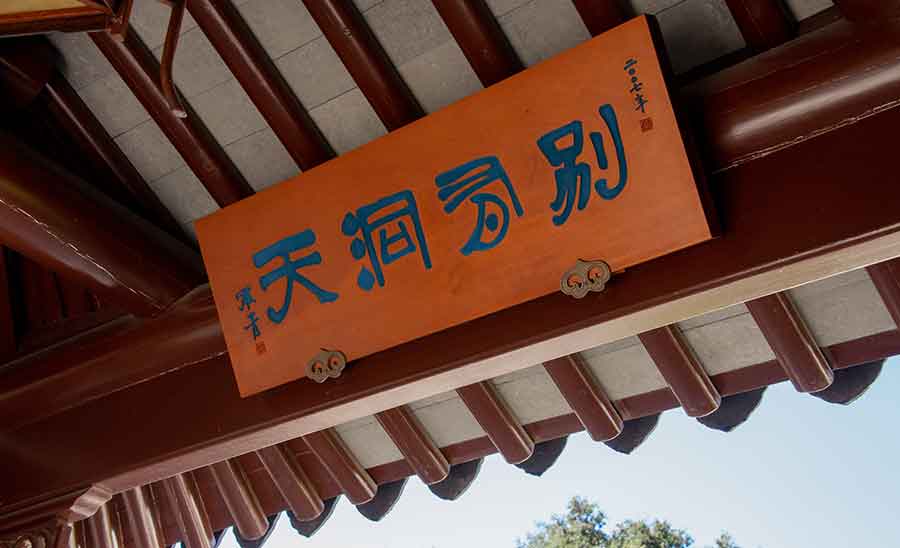
Stepping through the main doorway to the garden, the visitor is greeted by a wooden placard that reads: “Bie You Dong Tian” 別有洞天, or “Another World Lies Beyond.” Photograph by Deborah Miller.
Stepping through the main doorway to the garden, the visitor immediately is greeted by a placard that encapsulates this sentiment: “Bie You Dong Tian” 別有洞天, or “Another World Lies Beyond.” The word translated as “world,” dongtian 洞天,more literally means “grotto-heaven,” a term derived from the widespread belief in premodern China that caves served as portals to other lands. Engraved in a wooden placard and pigmented a rich blue, the characters are playfully distorted. Lo Ch’ing 羅青, a painter, poet, and calligrapher active in Taiwan, has written them with a sense of painterly liveliness different from the elegant stability of many of the garden’s other inscriptions, which more fully embody premodern precedents. In fact, the form of Lo’s characters seems to have been subtly transformed to complement the meaning of the phrase: the character bie 別 (“another/beyond”) seems ready to take flight, leaping toward the upper right; a crescent moon appears to shine beneath a cliff-like overhang in you 有 (“lies”); while beads of water on the left side of dong 洞(“grotto”) drip beside a cavernous mouth.
The phrase that Lo has inscribed derives from “The Peach Blossom Spring” (Taohuayuan ji 桃花源記), a fable composed by Tao Yuanming 陶淵明 (365?–427), a quintessential recluse who retreated from the fractious political arena of his era to return to farming and writing. Tao’s tale concerns a fisherman who wanders through a hole in a mountain and discovers a paradisiacal land untouched by time. Lo’s inscription thus evokes the ideal of utopian reclusion; but more importantly, in imbuing his calligraphy with a playful spirit less common in premodern inscriptions, he seems to suggest that classical references can still provide fertile ground for contemporary creative experimentation.
Although Liu Fang Yuan as a whole can be seen as a space separated from the mundane world of daily life, its embodiment of the reclusive ideals so celebrated in premodern gardens is perhaps most palpable in the Pavilion for Washing Away Thoughts (Di Lü Ting 滌慮亭). This small, open-air thatched hut is hidden among the oaks and camellias that line the stream connecting the Chinese and Japanese Gardens. Its name draws inspiration from a memorial that Liu Zongyuan 柳宗元 (773–819), a well-known poet and essayist of the Tang dynasty, offered in thanks to the emperor for his gift of mind-clearing tea.
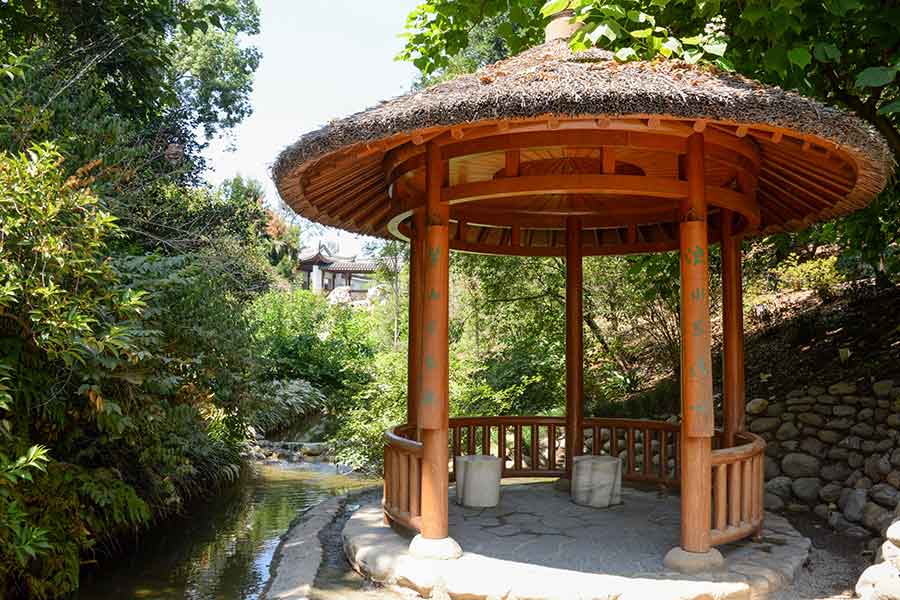
The Pavilion for Washing Away Thoughts (Di Lü Ting 滌慮亭), hidden among the oaks and camellias that line the stream connecting the Chinese and Japanese Gardens, is adorned with a simple poetic couplet engraved into bamboo boards. Photograph by Deborah Miller.
The pavilion is adorned with a simple poetic couplet engraved into bamboo boards. Read from top to bottom, right to left, it can be directly translated to read:
Flowing water can purify the mind;
fragrant mountains are good for quiet contemplation.
流水可清心,芳山宜靜觀。
The poem was composed and inscribed by Richard Strassberg, who signs the couplet with his Chinese sobriquet: Shi Tingquan 石聽泉—literally, “The Rock that Listens to the Stream.” Consisting of only 10 characters, the verse typifies the thematic and formal traits of the couplets found throughout Liu Fang Yuan and other classical Chinese gardens. Thematically, it speaks to the desire to separate oneself from the concerns of daily life: by entering the space of the garden, one can forget external concerns and clear one’s turbid thoughts. Formally, the couplet evokes these sentiments through the construction of parallel phrases whose meaning may be contrasting or complementary. “Water” (shui 水) and “mountains” (shan 山), for example, are contrasting features that are invariably paired in Chinese poetry; when joined together, these characters form the word for “landscape” (shanshui 山水). “Purifying the mind” (qing xin 清心)and “quiet contemplation” (jing guan 靜觀) are complementary activities: each is related, though not identical, to the other.
In premodern China, the ability to compose such parallel verses was expected of literate men and women. Garden-goers would even challenge their comrades to compose couplets in response to specific views and according to precise formal structures (including rhyme schemes and tonal patterns); given an opening line, they would compete to complete the couplet with a subtle complement or contrasting closing. Such poetry gatherings attest to a striking fact: although gardens were conceptualized as sites of retreat, reclusion was often pursued in the companionship of like-minded others and led to the collaborative production of literature and art. (In the months ahead, schoolchildren who visit Liu Fang Yuan will have the chance to compose their own verses as they participate in our “Poetry in the Chinese Garden” school tours.)
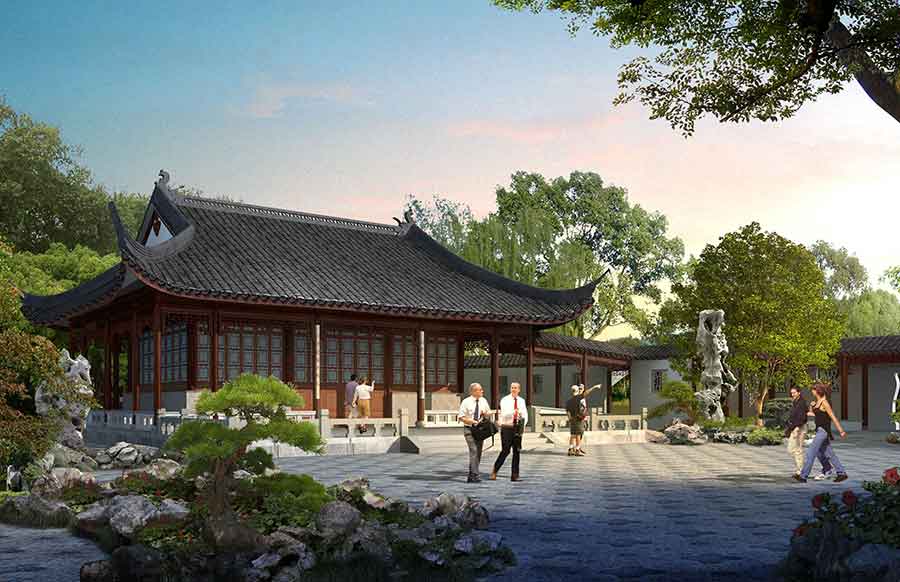
Artist’s rendering of the Flowery Brush Library 筆花書房. Designed in the style of a scholar’s studio for painting and calligraphy, the Flowery Brush Library is part of an exhibition complex that will feature cultural programs, demonstrations, and displays of Chinese art. The Huntington Library, Art Collections, and Botanical Gardens.
Strassberg’s couplet, like Lo Ch’ing’s placard and Wan-go Weng’s inscription, exemplifies the spirit in which the Garden of Flowing Fragrance was founded and constructed. On the one hand, their works, like the garden as a whole, draw from historical traditions to create an experience of Chinese cultural themes that visitors can read in the present. On the other hand, in their act of adapting and transforming premodern works of literature and art to respond to the specific site of Liu Fang Yuan, these artists attest that the garden can continually inspire new creation—creation that, nevertheless, remains cognizant of the past. Liu Fang Yuan, we hope, will always be a place in which the past and the present meet productively and creatively, much as was true in premodern gardens.
This final phase of the garden’s construction will entail the addition of spaces that underscore the fundamental importance of artistic and scholarly activity to the Chinese Garden. These spaces include a small art gallery (“Studio for Lodging the Mind,” Yu Yi Zhai 寓意齋) and a scholar’s studio (“Flowery Brush Library,” Bi Hua Shu Fang 筆花書房). In these buildings, and throughout Liu Fang Yuan more broadly, we will organize exhibitions, invite artists to create works that respond to the garden, and host programs—calligraphy workshops, school tours, musical performances, academic seminars, and more—inspired by the site. In this way, we will continue to write the text of Liu Fang Yuan.
Phillip E. Bloom is the curator of the Chinese Garden and director of the Center for East Asian Garden Studies at The Huntington.